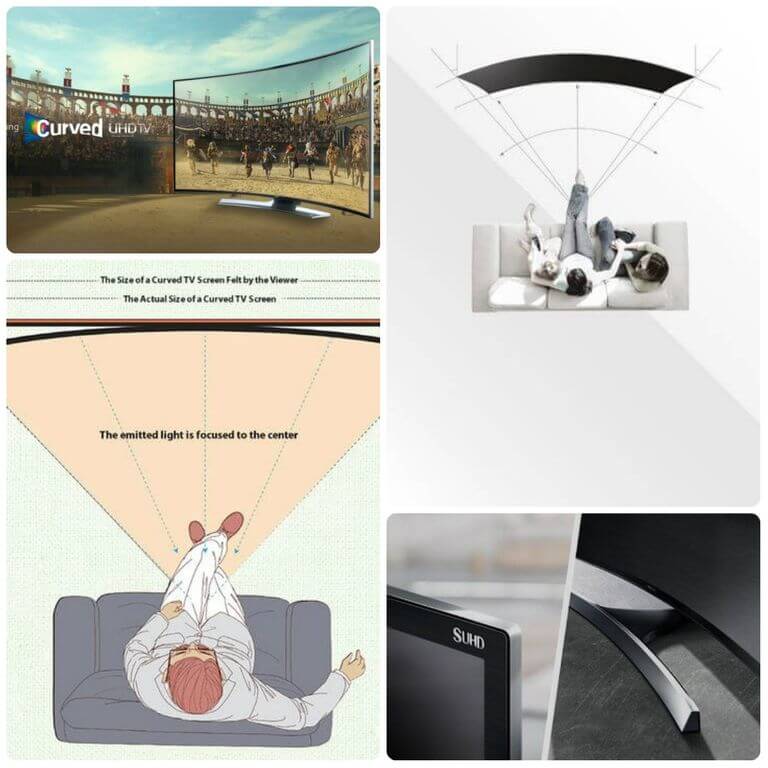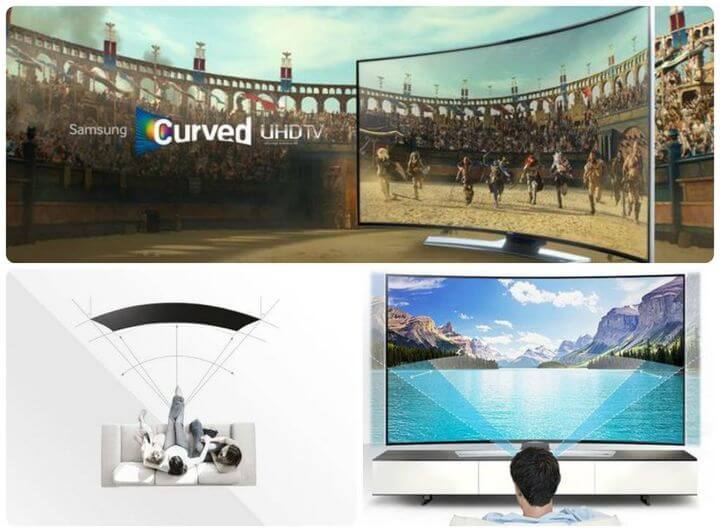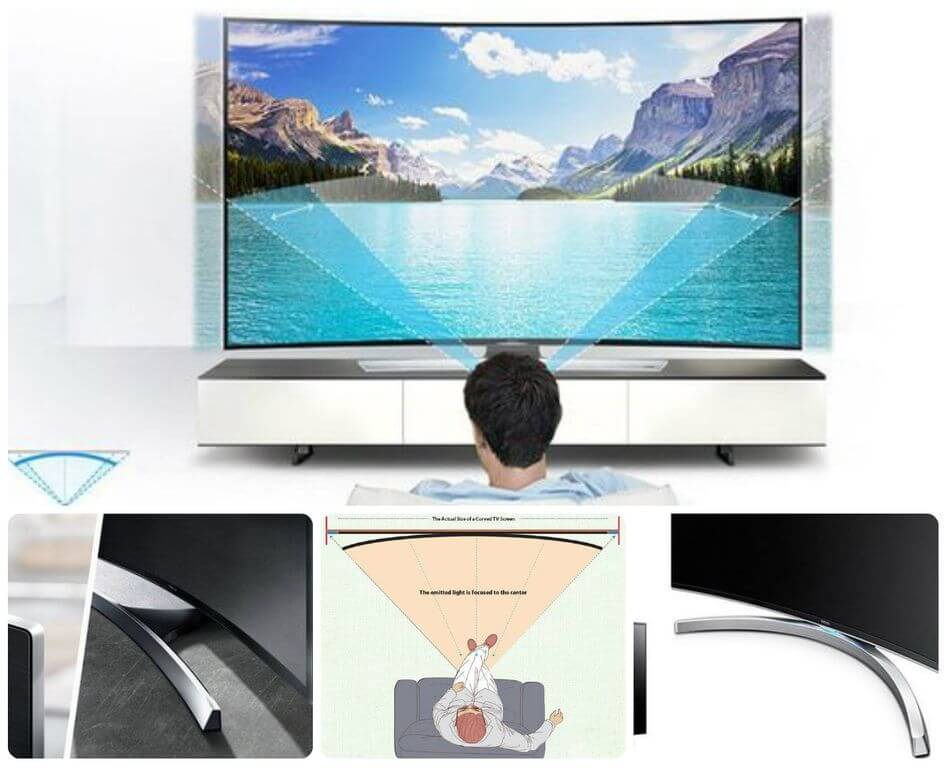How realistic are the benefits touted by consultants shops selling fancy new smart TV definition, the screen of which has a curved screen? And what particular nuances they intentionally hold back?
Advertising their goods, sellers assure buyers that their purchase will provide “the effect of IMAX” in his private apartment. But is it really so the pronounced effect is obtained presence to clearly give preference to models having the curved screen? That finding answers to this question and we are dedicated to our article.
The market appearance of the first new smart TV definition sets with a curved, and is correct to say with a concave screen happened a few years ago. The manufacturers of LCD panels, thus, were another attempt to attract buyers. The models differ not only the original design but also the fact that the viewer gets a new experience, browsing videos or TV-program.
The most active promoter of new models becomes LG and Samsung. Thus, the statistics produced models by Samsung in 2015, the total number of which reached fourteen, as follows:
- Five follow the format curved;
- Three models are available with a flat-screen TV and a curved;
- Only six had a flat screen TV.
Against the background of the above-mentioned companies, new smart TV definition Panasonic looks unconditional conservative in this matter. However, in a number of their products are models equipped with curved screens, and not in the singular form.
What is attractive about these models of the new smart TV definition?
According to the manufacturer, thanks to a design of the screen is possible to achieve under review to increase its size. After all, when watching programs on a traditional flat-screen viewer does not provide a uniform image color perception. This is because the distance to the left and right borders of the screen to somewhat more than the viewer’s eye to its middle. So these glow zone passes by the axis of human vision.
To solve this problem and it was suggested to bend the screen so that it fits in the radius of a circle with a diameter of four to five meters. At the same time, the viewer the impression that the model size increases and the screen have a diagonal of 55 inches is perceived as 60 inches.
In addition to what is happening visually increase the width of the screen. The positive characteristics of curved panels also include an increase in the viewing angle, improving the performance of contrast and reduce the amount of glare and reflections.
What sellers are silent about new smart TV definition?
For example, they neglect to mention that the value of the real growth of perception is directly dependent on how far away from the new smart TV definition viewer is located. So if viewing on a new smart TV definition transmission is carried out, which has a diagonal of 55 inches from a distance of five meters, the amount of growth will not exceed 3%, that is, for the viewer, it will be virtually unnoticeable.
Another point, which prefer is not to mention manufacturers – what area, which allows for comfortable viewing. But it is located within the sector, which limits the field of television. And if people are flat panel receives the picture looks about the same, then, for those who enjoy curved screen be considered the value sweet spot – very good location when viewing. This means that any breach of the border, which is comfortable to view, lead to a leveling of the benefits available to the curved screen.

The viewer is not located at the point, which is called the sweet spot, and located on the left side or the right of it is improved overview of the side of the screen, which is located remotely from it. While the appearance of the proximal end is drastically deteriorated, due to a more acute angle at which the image falls on the retina of the viewer. This phenomenon gives reason to believe that there has been a decrease, compared to the usual flat panel, worsening visibility. Some users also talk about the fact that there are also certain geometric distortions.
It should also be noted that all artifacts concavity effect on the perception of the audience are at least to be larger than the screen size. Therefore, the actual result can be expected, provided that its diagonal is not less than 55 inches. And the bulk of marketed our units is equipped with 40-inch screens.
According to specialists, in order to achieve the effect of ensuring the presence of the screen should be closed at least 40% of the field of view. This means that if the screen is the curvature radius of five meters, then a screen size should be more than a hundred inches or viewer must sit very close to the screen.
Today’s reality is that the preferred installation looks concave displays on monitors than the new smart TV definition. After all, most of all, the computer is only one person who is close enough on the screen. This allows the effect of presence, even in such a relatively small diagonal, as the twenty-seven inches already from a distance of about sixty centimeters.
On the positive and negative aspects of the concept
Of course, the positive is the caveat that with the help of a concave screen fails to deal effectively with such a drawback, as the decline in the contrast at the boundaries of the display. However, this is best shown in the matrix TN, which is often used in low-cost devices having a small diagonal. When using the matrix IPS or VA, used on expensive TV, this advantage occurs leveling.

For obvious disadvantages concave screens, of course, is the presence of optical distortion, the change for the worse viewing angles and contrast ratio to viewers located outside your comfort zone view. Also, be aware that video footage broadcast on the concave screen acted without regard to its constructional features. After all, the modern film industry is focused on the reproduction of its products only on a flat screen.
Due to the increasing cost of production of the concave screens of the new smart TV definition, compared with the manufacture of flat models. The buyer curved screen have to face the significant increase in cost, which, according to experts, it is not justified by the benefits add. Also conducted online editions of the so-called blind tests, suggest that the bulk of the audience may not immediately find differences between working flat and curved panels. This suggests that there are no significant differences, the surprising novelty in the transition from flat to curved panels.

Leave a Reply